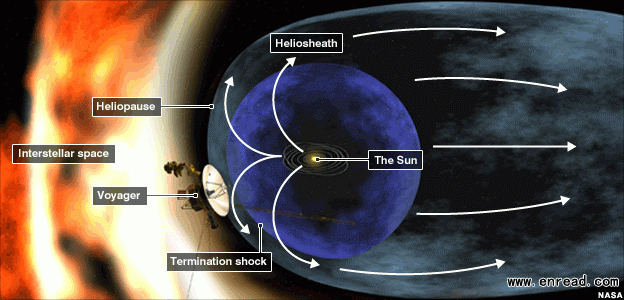| ||||||||||||||||||||||||||||||||||||||||||||||||||||||||||||||||||||||||||||||||||||||||||||||||||||||||||||||||||||||||||||||||||||||||||||||||
|
Humankind's most distant emissaries are flying through a turbulent sea of magnetism1 as they seek to break free of our Solar System. 人类在太空中最远的探测器正在穿越一片磁海湍流,目前它正试图冲出太阳系。  The Voyagers are approaching the edge of the enormous sphere of charged particles the Sun has thrown out into space That information has allowed scientists to build a better picture of what conditions are like in the zone where matter blown out from our star pushes up against interstellar(星际的) space. Computer modelling based on the Voyager insights suggests the edge of our Solar System is a froth of activity, like "an agitated2(激动的) jacuzzi", said Eugene Parker from the University of Chicago, US. Magnetic field lines carried in the "wind" of material coming off our star are breaking and reconnecting. This process is sculpting3 the wind into discrete4(离散的) bubbles that are many tens of millions of kilometres wide. Researchers say this assessment5 has implications for our understanding of cosmic rays - the storm of high-energy particles that are accelerated in Earth's direction by exploded stars, black holes and other exotic locations in the galaxy6. Ray effects It is highly likely the mass of individual magnetic structures actually makes the Solar System more porous7(多孔的) to cosmic rays. "It's more like a membrane8 that is permeable to the galactic cosmic rays, so we expect the galactic cosmic rays to enter and slowly wander through this sea of magnetic bubbles until they can access field lines that connect back to the Sun and quickly escape," explained Professor Parker. The observation is of interest not just to physicists9 but also to astronauts, who must protect themselves from the damaging health effects of cosmic rays, and to spacecraft engineers who have to "harden" the electronic circuitry in satellites against the impacts from high-energy particles. The modelling results will make no difference to their predicament(窘况,困境) ; but it does say something about why the cosmic ray issue takes on such importance. Researchers confess to being surprised; they thought the outskirts10 of our solar neighbourhood would be more sedate11 - that the Sun's field lines would simply turn around and reconnect with the Sun. "The findings are significant as we will have to change our view on how the Sun interacts with particles, fields and gases from other stars, and this has consequences that reach down to Earth," commented Arik Posner, Nasa's Voyager programme scientist. It is a demonstration12 once again of the extraordinary capabilities13 of the Voyagers, which continue to excite and intrigue14 more than three decades on from their launch. Voyager 1 was put in space on 5 September 1977, and its sister spacecraft, Voyager 2, lifted off on 20 August 1977. The Nasa probes' initial goal was to survey the outer planets Jupiter, Saturn15, Uranus16 and Neptune17, a task completed in 1989. They were then despatched towards deep space, in the general direction of the centre of our Milky18 Way Galaxy. 点击  收听单词发音 收听单词发音
|
||||||||||||||||||||||||||||||||||||||||||||||||||||||||||||||||||||||||||||||||||||||||||||||||||||||||||||||||||||||||||||||||||||||||||||||||
上一篇:想买合身牛仔裤 找3D身材扫描仪帮忙 下一篇:核事故使女婴出生量减少 |
||||||||||||||||||||||||||||||||||||||||||||||||||||||||||||||||||||||||||||||||||||||||||||||||||||||||||||||||||||||||||||||||||||||||||||||||
- 发表评论
-
- 最新评论 进入详细评论页>>



